Kanazawa, Shirakawa-go and Takayama
In our last travel blog post, we visited some amazing Japanese temples and experienced the annual cherry blossom spectacular.
In this update, we decided to travel into the countryside so we set off in direction of the Japanese Alps. We would be traveling to Kanazawa by train then by local buses through the mountains to Shinikawa-go before ending up in Takayama. We hoped to see a bit of snow, some mountains and get a taste of a more rural Japan.
Traveling from Osaka to Kanazawa
This journey is a two and half hour train ride from Osaka, not a great distance, but a lot of it is uphill as you make your way into the Japanese Alps so I suppose it would be a little too much to ask for a bullet train to get you there.
This city is famed for two things, its Kenrokuen Garden (said to be one of the three most beautiful gardens in Japan) and secondly its Kaga Cuisine. The food, not surprisingly, given its coastal location centres around seafood notably crabs, oysters, and squid. Fish can be found on the menu at restaurants and in the fantastic local market.
We were here on an overnight stop and decided the garden would be a good starting point for us to work up our appetite before sampling the food. We awoke on our first full day there to a most beautiful spring morning.
We decided to walk from our hotel to the gardens rather than take a bus. The city is not too big and a stiff resolve and some comfortable walking shoes can get you round it without the need for public transport.
The walk there took us through a park and we saw stalls being set up for what looked like the city’s Sakura (cherry blossom) festival, we would pop back later to see what was happening.
The gardens are perched on a hill in the middle of the city, and were full of pine trees and a whole variety of fruit blossom trees. Not surprisingly cherry was in abundance, but also plum trees. The fruits trees were in blossom, but looking at some of the pictures in the tourist guide I think the gardens probably look a whole lot more impressive in summer and Autumn. It was worth a visit though and we were not disappointed exploring a traditional Japanese garden.
Saki Tasting & more Japanese Street Food
It was getting towards lunchtime and our stomachs had decided that it was time to set off for the market. Rather than eat in a restaurant we had decided that we could sample far more of the local delicacies if we spent some time wandering round Omicho market, buying whatever the stallholders had to offer.
It was a good decision and lunch consisted of oysters, sashami, sushi, smoked fish skewers and what are fast becoming one of my Japansese favourites, potato cakes (korokke). The ones from the stall in this market came filled with shrimp and octopus. Yum yum yum
Before we headed back to the Sakura party we had a look at the Modern Art Museum. To be honest it was all a little ‘too modern art’ for me – one exhibit consisted of a 10 meter piece of fabric slung accross a room!
There was one saving grace though the The Swimming Pool installation by Leandro Erlich. From above it looks like a swimming pool, but in fact the water is suspended in a 10cm layer of glass allowing you to walk under it where it is fitted out just like the insides of a pool and you watch the people from above staring down through the water. Very creative – we both liked this contemporary installation a lot.
We headed back to the Sakura party in the park. Things were warming up nicely, with an array of about forty stalls selling local arts and crafts. The stage was filled with what looked like the Japanese equivalent of local amateur dramatic and opera societies doing their turns on the stage. I am being cruel there, we were actually entertained enough to stay and watch for an hour before heading back, packing up and getting ready for our mountainous coach journey to Shirikawa-go early the next morning.
One thing we have noticed as we visit the tourist destinations on our travels is the number of Japanese male tourist groups dressed in business suits. We captured this group on the way to the gardens here. It was a Sunday so they couldn’t have been on a quick lunchtime trip. Haven’t worked out what this is about yet but we will try and find out.
The Journey from Kanazawa to Shirikawa-go
The jouney to Shirikawa-go takes about an hour and you find yourself heading further into the Alps. I’m sure in bygone days this journey would have taken hours. However the ever efficient Japanese have ploughed a tunnel (Japan’s second longest) through the mountains to cut the journey time to just under an hour.
Given its remoteness, until the building of this new tunnel express way, the village of Shirikawa-go has remained relatively untouched and thus has recieved UNESCO world heritage status.
The village consists of traditionally built ‘snow houses’ with steep thatched roofs and paddy fields dotted about. You have a choice of houses to visit (for the now familiar 300Yen fee) to have a glimpse of life before the arrival of the tourists . We ambled round the village and tried to photograph what we could under the dark skies. It was good to see snow after nearly four months of sunshine in the southern hemisphere and we played snowballs – till our hands got cold.
We could however, have done without the lashing rain, grey skies and a chilly wind. Unfortunately, it remained that way for the few hours we stayed there. We decided to get out early and make our way to Takayama.
We arrived at the ticket office just before 12 and asked to change our pre-booked tickets to an earlier bus, its advisable to do this as there aren’t many buses here and they get booked up fast. We found out that a bus was just about to leave. What the ticket office didnt know was that it had just pulled out of the station.
John gave chase and did some magnificent sign language to the driver to hold the bus while I exchanged the tickets and retrieved our backpacks from the coin lockers. We were therefore personally responsible for making a Japanese public transport service late. I thought we were going to be hung when we arrived at Takayama five minutes later than scheduled. Its just not the done thing in Japan…. Heads bowed, we scuttled off the bus sharpish.
Takayama
We were in Takayama for one night only and given our early departure from Shirikawa-go we decided to stuff our backpacks in a locker and explore the town before heading to our hotel in Hida village just outside town. They’re quite strict in Japan about the standard 3pm arrival when you check-in to your hotel or accommodation.
Its worth me having a little comment here about the coin lockers in Japan. They are at every transport terminal you visit and are a great asset to the busy traveller. For 500 yen (£5) you can store two very big backpacks for the day while you go out and enjoy the sites. Our flashpacking adventures in Japan wouldn’t be half as easy if you didn’t have this brilliant service available.
We walked across the many bridges enjoying the views and sounds of the river, as the mountain river cuts through the town. We then we wandered into the old Geisha district. The weather was better than in Shirikawa-go (no rain but still decidely chilly) so we decided a bit of saki tasting was in order to warm us up.
All the shops in this old and picturesque district positively encourage you to try the various vintages. Who were we to argue, so we slowly worked our way down the street sampling the regions finest. Saki is at its best when you have fine rice and clear pure water (something they have in abundance in this region given the mountain streams) so the tastings were without exception perfectly palatable. Our favourite was a cherry blossom vintage.
We staggered walked back to the station to pick up our luggage and headed off to our mountain hotel. It wasn’t quite a Ryokan but it was a more traditional Japanese hotel than we had stayed in thus far.
What it lacked in amenities you got back in space. The room was large by Japanese standards. It was also close to the main attractions in this area by the traditional Hida village. The village is a collection of traditional Japanese dwellings that represent the different building styles accross the centuries and from the regions across this area of central Japan.
It is done rather well and you can don slippers and wander about inside the different houses. One nice touch at the end is a room with a traditional sand fire where you can have a cup of green tea and a relax before you set off on your next sighhtseeing adventure.
We sampled the local Hida beef while we were here which, like the world famous Kobe beef, is a fatty marbled affair that is about as expensive as caviar. I cant say I was bowled over by it, but we can now say we have tried it.
I sensed a bit of rivally between the Kobe and Hida beef producers. I bet if you put two slabs side by side 99% of the people couldn’t tell the difference, but each region to their own I say.
We had an early afternoon train booked back to Tokyo, so again made use of the station lockers and spent our final morning wandering the two local markets. They are not large, but promised lots of local produce. As we had not yet eaten breakfast we decided on a mission to fill our bellies with the food tasting samples on offer at the various stalls.
This was a fantastic challenge and we ended up tasting some quite wonderful and untried local delicacies. These ranged from spiced bamboo shoots, red ginger, a variety of chutneys (I am sure they are not called that here), green tea laced with manuka honey and blueberries. My absolute favourites were the variety of mushrooms on offer, some like shitake we recognised, but others we had never seen before. I am a funghi fan so enjoyed them all.
We finished off by sampling some sweeter products. One stall was selling a sugary egg white concoction which was bliss and we ended with a small rice cake caramelly (is that a word) sweet bean curd filled ball – a perfect end to our market food hunting.
We were then on yet another train on our way back to Tokyo for a breif overnight stop before making our way to more of the Japanese Alps in the form of Yudanaka . On the way we got a wonderful view of Mount Fuji. Apparently a rare sight to find it cloudless, so I tried to get a snap out of the window from a train travelling at over 120mph – not easy.

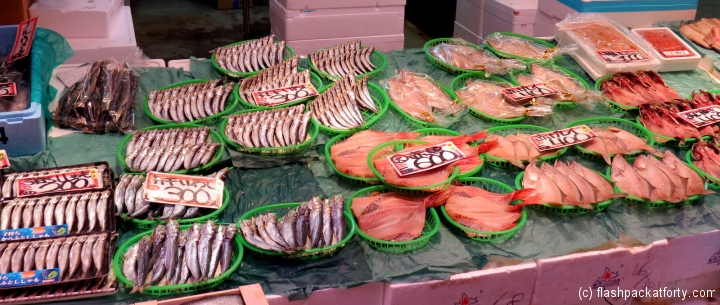
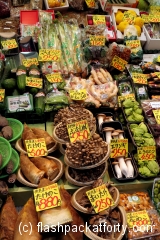

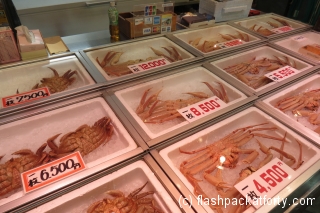
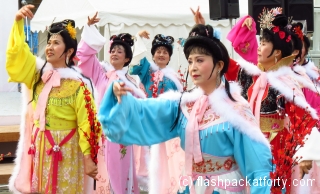
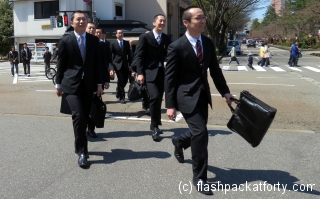
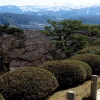



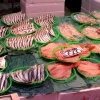
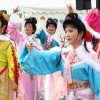




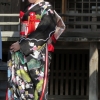

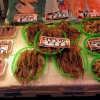
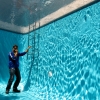

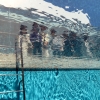
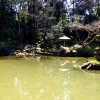

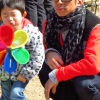
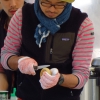

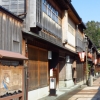
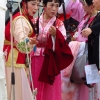
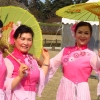
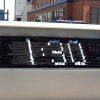
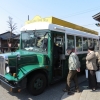
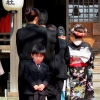
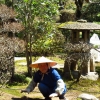
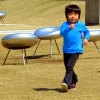



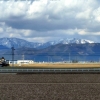
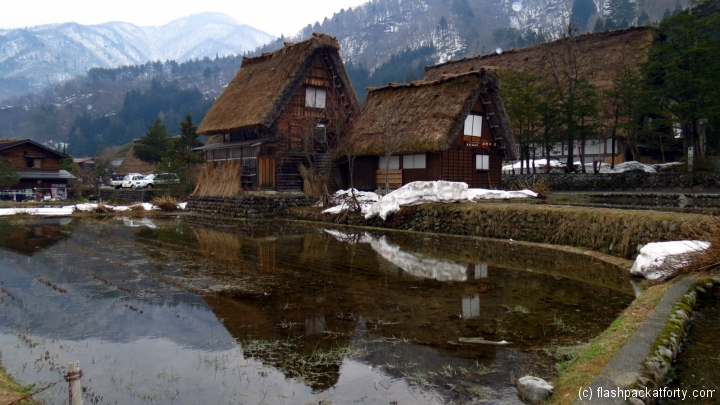

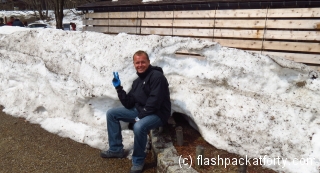
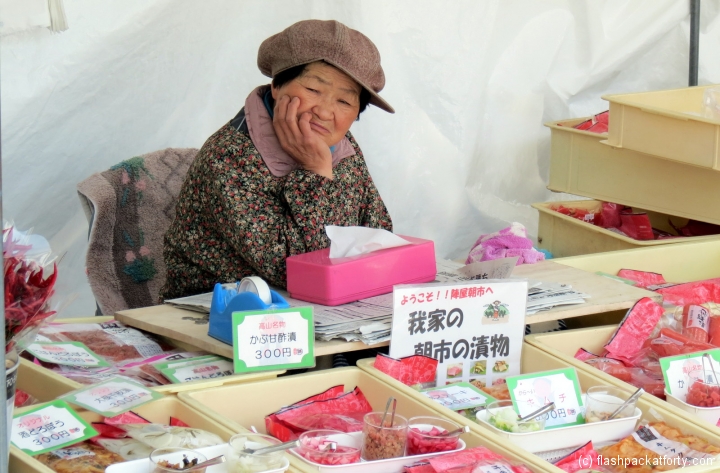
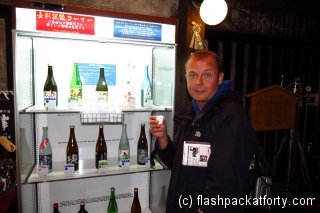
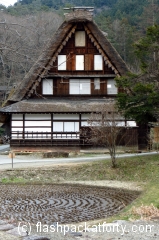
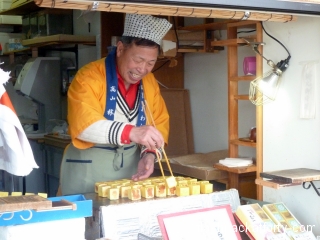
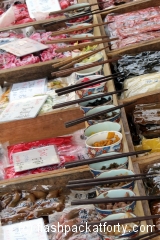
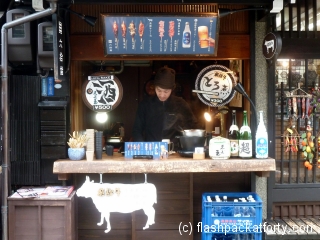
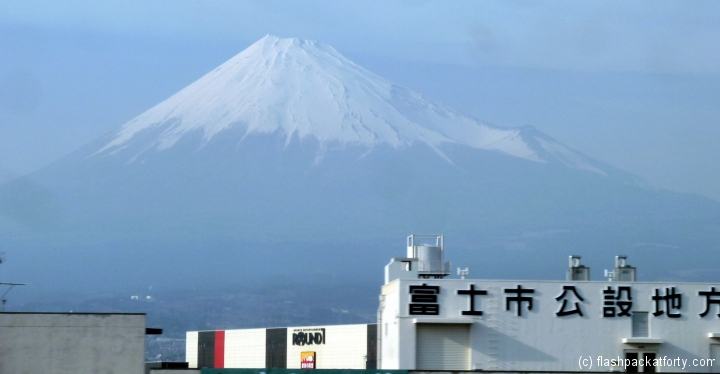
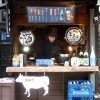
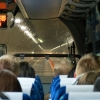

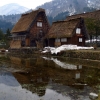
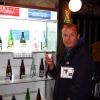
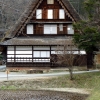
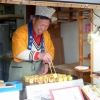
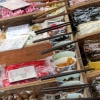
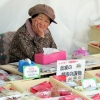
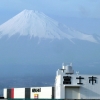

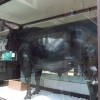
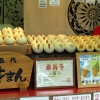
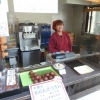
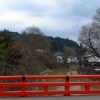
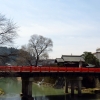
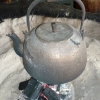

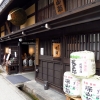
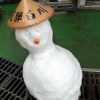
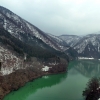

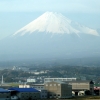
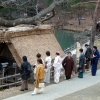

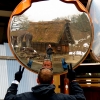
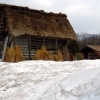
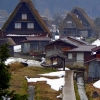
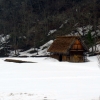


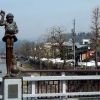
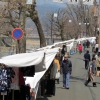
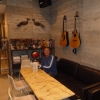


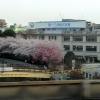






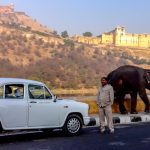
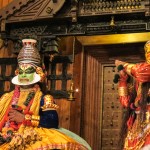

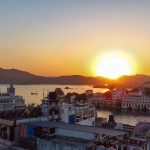

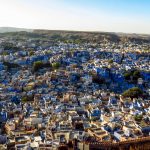




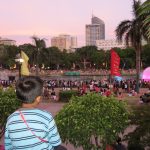
Is that a fountain clock? Very cool!
It was I stood watching it for ages.